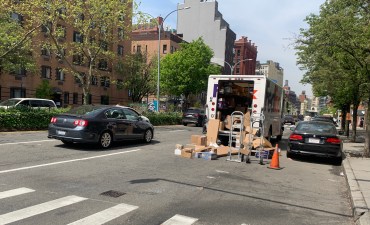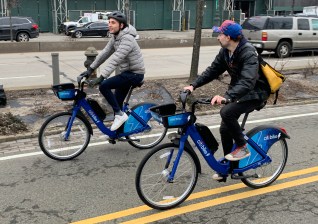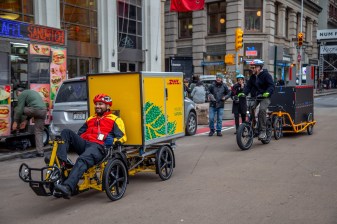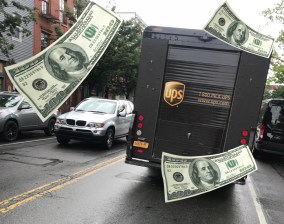Manhattan BP Candidate Seeks To Curb Sidewalk Package Warehousing Issue

He wants to deliver some relief.
Manhattan Borough President candidate and current West Harlem Council Member Mark Levine has a new series of proposals that he says will help stem the tide of e-commerce deliveries washing up on Manhattan’s shores.
The candidate is proposing a three-pronged approach to dealing with companies who have their drivers unload trucks on sidewalks, a situation about which residents of the Apple core have constantly groused in the age of online shopping. Levine’s proposal calls for dealing with the issue by repurposing space in parking garages as staging areas, building micromobility-friendly loading zones around the borough and encouraging companies to shift their deliveries to e-bikes.
“We’ve done shockingly little to adapt to the explosive increase in online deliveries that are changing the streetscape in Manhattan and creating problems of double- and triple-parking and bus lanes and bike lanes that are blocked and sidewalks that are overcrowded by companies doing parcel sorting,” said Levine. “And I think some deliberate policy could really easily end that and it just requires, I think, a smarter use of street space and some other existing assets.”
One plank of the plan very literally takes delivery staging off the street, as Levine suggested a zoning code change to allow parking garages to rent street level space to delivery companies in order to let their drivers unload and warehouse delivery items, which can then be delivered by foot or by bike. The land use change could require going through the dreaded ULURP process, Levine said, though his campaign is still studying what can be done without opening that door.
“I actually think that the politics on this are good,” he said. “For the parking garages, it simply opens up a new option for revenue. There’s no downside for a parking garage to having this option. And same for the the online delivery companies. And for neighborhoods, it gets it gets that that congestion off the streets and sidewalks.”
Parking garages as warehouse spots should make Levine’s other two delivery ideas work more smoothly. One part of the delivery agenda is switch 50 percent of all e-commerce deliveries to cargo bike deliveries by 2026. For that, Levine said that in addition to incentivizing companies to make the switch to cargo bikes, he’s committed to both expanding the amount of bike lanes in Manhattan, and changing their design in order to fit the bulkier rides.
“A component of our of our multi-year plan to get to 50 percent by 2026, is to re-examine the bike lane network to make it, or at least key components of it, accessible for these kinds of cargo bikes,” said Levine. “This is why some other parts of the world have done more than just dedicated slices of the street, they’ve created bike highways where you can have ample space for two-way traffic. That’s the kind of thing that would allow for more room for these vehicles.”
Levine is also calling for an expansion of what he calls green loading zones, which would be loading zones for electric delivery vehicles or cargo bike corrals installed in more than just Whole Foods-adjacent streets. Levine stressed that he wanted a boroughwide comprehensive plan for these loading zones, instead of piddling pilot programs or the DOT’s block-by-block trench warfare to install the cargo bike corrals. Cargo bike corrals with bike parking and charging equipment for e-bikes would make parking a car or truck in one difficult, bur Levine admitted there would still need to be enforcement and outreach issues to keep loading zones clear for something like an electric delivery van.
“We’ve had this exact challenge in my district with the car-share spots on streets, with challenges of people putting their car there. It’s enforcement, but also, it’s education. Our message on the care share spots is that, on average, 50 people share every car share. And aren’t you happy to have the other 49 cars not on the street competing for parking? People just have to connect the use of the street space to the real, tangible benefit to the neighborhood. And yeah, that that that’s a communications challenge, which we have to keep working on, but we’re slowly making progress on it,” he said.
Most of Levine’s ideas will require buy-in from delivery industry players, parking garage owners and, of course, the next mayor. But there’s still room for the borough president to shape the streets agenda on their turf.
“To the extent that there are land use actions required for in the short term, re-purposing some garage space, and in the medium term, for allowing for creative creation for new last mile distribution centers, all of those go to the desk of the borough president,” Levine said. “So much of this is litigated in community boards, which we know have recommendation power, but in practice certainly influence our policy outcomes, and the borough president makes the lion’s share of appointments and runs the boards. And I think it’s really powerful to have someone in this role, putting out an agenda and organizing to help achieve it, even if some of the levers are indirect.”
Levine’s delivery plan has him kicking into high gear in the livable streets debate for the Manhattan BP’s office, one that Upper East Side Council Member Ben has been centering with his pushes for a dedicated bike lane on the Queensboro Bridge, bike parking and right-sized equipment for cleaning the city’s bike lanes. Elsewhere in the race, State Senator Brad Hoylman has embraced a future car-free Manhattan, Lindsey Boylan has called for more bike lanes and pedestrian spaces in the borough and current World Economic Forum executive and former Chair of Manhattan Community Board 7 Elizabeth Caputo has a history of pushing for pedestrian and bike safety measures on the board.
Catch every candidate fight it out for the bike vote next month, at Bike New York’s Manhattan Borough President Forum on May 10.





